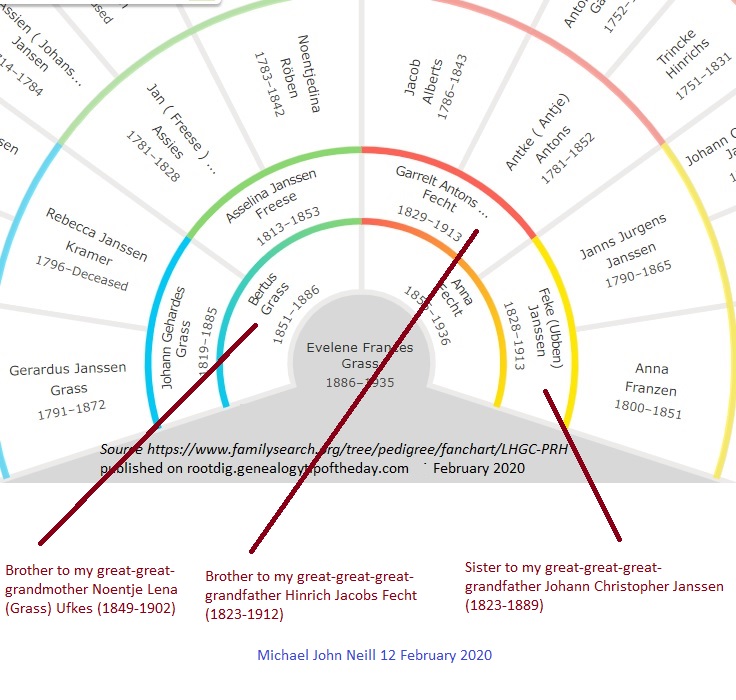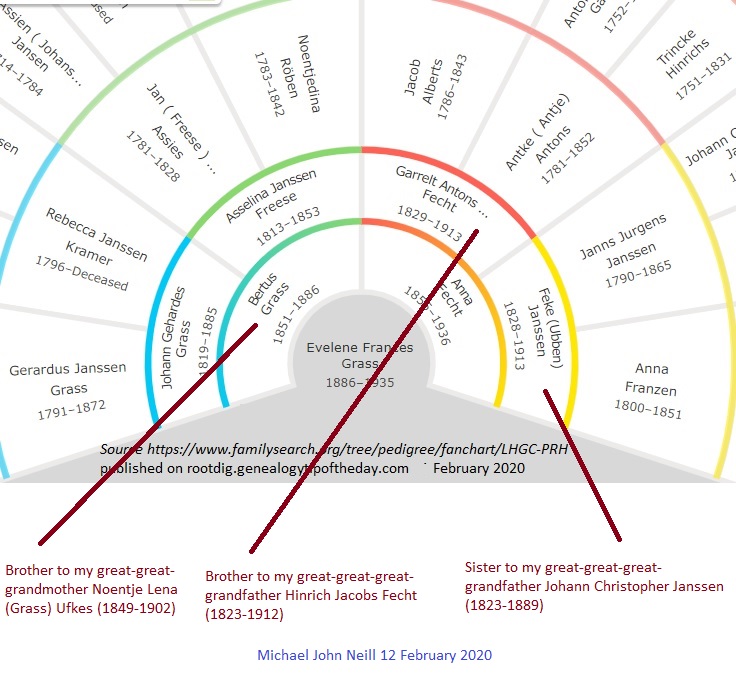
The phrase “complete relative” is one that I made up because it seems to fit the situation. E. Grass (1886-1935) is related to me in three ways. The relationship is such that when one gets to her great-grandparents every one of her ancestors is one of my ancestors.
The reason is fairly simply (or maybe not depending upon your perspective). Her father and her mother’s parents are all siblings of one of my ancestors.
- Bertus Grass–her father (1851-1886) was a brother to my second great-grandmother Noentje Lena (Ufkes).
- Garrelt Fecht–her maternal grandfather (1829-1913) was a brother to my third great-grandfather Hinrich Jacobs Fecht (1823-1912).
- Feke (Janssen) Fecht–her maternal grandmother (1828-1913) was a sister to my third great-grandfather Johann Christopher Janssen (1823-1889).
The Fecht and Janssen families were from Wiesens, Ostfriesland, Germany. The Grass family, originally from Backemoor, moved there some time after Bertus and Noentje Lena were born.
I’m not certain if any descendants of this relative have done a DNA test or not. If they have, their tree is non-existent and looking at their shared matches will be a challenge since there are other double connections I have to the Fecht and Janssen families.
On paper, E. Grass’s tree represents 1/8th of my genealogical tree. That’s because:
- My great-great-grandmother Noentje (Grass) Ufkes represents 1/16 of my paper tree.
- My great-great-great-grandfather Hinrich Fecht represents 1/32 of my paper tree.
- My great-great-great-grandfather Johann Janssen represents 1/32 of my paper tree.
Just because E. Grass’ tree represents 1/8th of my tree does not mean that if she had tested that 1/8th of my DNA is also hers. That’s not how DNA inheritance works, particularly since her relationships to me are:
- first cousin three times removed through the Grass relationship (she was a first cousin to my great-grandfather Ufkes).
- second cousin three times removed through the Fecht relationship (she was a first cousin to my great-great-grandmother Habben).
- second cousin three times removed through the Janssen relationship (she was a first cousin to my great-great-grandfather Janssen).
The nature of our relationship does mean that if a descendant of hers tested, I’d have to analyze those results very carefully and would make no initial conclusions about any shared matches that we had.
And we certainly would have shared matches.


2 Responses
As one inherits 50 % of the dna from each parent, you would think you would get 25 % from each grandparent. However it could be as little as 0 and max of 50%. Each 50% is random. If your parent did not inherit it, you never would but if they did you have inherited it, you have a 50% chance of getting it. Clear as mud right.
if you have double and triple related ancestors their dna may show higher then normal % expected.